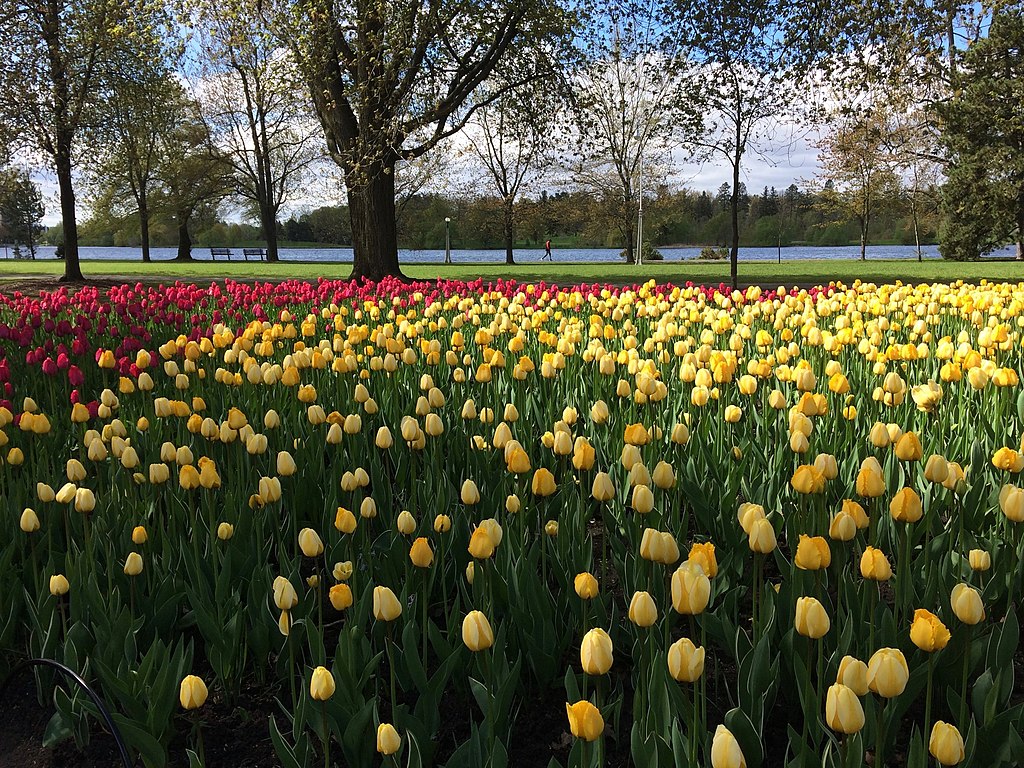
Flower Bulb Planting Guide: 10 Tips for Commercial Landscapes
Flower Bulb Planting Guide: 10 Tips for Commercial Landscapes
Planting flower bulbs is the ultimate plan-ahead gift you give yourself and your customers.
Tuck ordinary-looking bulbs in the ground in the fall, and celebrate in the spring with an explosion of cheerful color.
Spring bulbs are like a party on your property, shouting the blissful arrival of spring in riotous hues of red, yellow, purple, pink, coral and blue. They’re the first thing you see in the spring, before other flowers appear.
You don’t have to look too hard here at Level Green Landscaping to find bulb super fans, including the company’s managing member and head gardener Doug Delano, who has personally planted close to 50,000 or so daffodils and tulips at his home in Maryland.
Just a fraction of that number can make a huge impact on your commercial property.
But you have to plan ahead.
When to plant bulbs? Where to plant bulbs? What kind? How many?
Plant spring bulbs from the end of September through October, in high visibility spots throughout your commercial property, from entrances to signage to huge impressive masses in beds and borders. What types of flower bulbs thrive here? Tulips and daffodils are always favorites, but crocuses and hyacinths also add a cheerful boost your customers and tenants will love.
Need a bulb planting guide? Keep reading to learn more about tips for planting bulbs, including:
When to plant bulbs
Where to plant bulbs
Types of flower bulbs
Planting flower bulbs: top tips
You can’t go wrong with tulips
Delightful daffodils
Combining bulbs with other plants
How many bulbs should you plant?
Your bulbs have bloomed! Now what?
Why leave bulb planting to the pros
1. When to Plant Bulbs?
Here in the Mid-Atlantic we plant spring bulbs from the end of September through October, when the soil temperature is consistently 60 degrees or cooler but before a hard freeze.
“If the soil is too warm, the bulbs could sprout too soon or rot in the ground,” says Bradley Sarno, enhancement operations manager at Level Green Landscaping.
You can’t decide in March that you'd love tulips in May. It’s all about planning ahead.
Crews plant spring bulbs at the same time they install fall pansies and violas.

2. Where to Plant Bulbs?
“Spring bulbs are great in all the normal spots where you’d plant colorful annuals,” Sarno says. “Entrances, around signage, in beds.”
If you have perennial beds on your property, filled with plants like ornamental grasses, daylilies, and rudbeckia, underplant them with bulbs. As the season goes on, those plants hide the fading foliage from the bulbs.
Do you have large expanses of turf? Areas of fields or meadows? Woodland areas?
Big areas like this look great with drifts of spring flowers mixed in, thanks to self-propagating bulbs that naturalize. Naturalized bulbs are scattered to grow in drifts that make it look like the flowers popped up naturally.
Naturalizing bulbs means planting large numbers of flowering bulbs informally, mixed in with turf or other plantings, so they look like they popped up naturally.
Certain flowers, like daffodils, are great for naturalizing, because they grow from self-propagating bulbs — they spread freely and multiply, so you get more flowers each year, without even trying.
No formal lines of flowers here — naturalizing bulbs are scattered to grow in drifts with gentle curves that flow throughout your landscaping.
Plant them once, leave them alone, and they come back each spring with even more vigor. A few hundred bulbs can become thousands.
You need at least a few hundred bulbs for a big impact. But remember, those few hundred self-propagating plants will turn into a few thousand over time.

3. Types of Flower Bulbs
Sarno’s favorites: tulips, daffodils, hyacinth and crocus.
If you mix different varieties of bulbs that bloom at different times, you can stretch the blooms to two to three months.
White snowdrops bloom early, in February. Mix in crocus, allium, daffodils and tulips, and you extend the blooming season to April.

4. You Can’t Go Wrong with Tulips
Tulips burst into vibrant bloom right when we need them, after a long drab winter.
They’re stunning in masses. For the biggest impact, mass one color.
“The great thing about tulips is they come in such a wide variety of sizes, shapes and colors,” Sarno says. Some types of bulbs don’t even look like traditional tulips, boasting stunning double blossoms or ruffly serrated edges.
There are fluffy pink beauties that look like roses. Striped varieties that seem hand painted by artists. Purple stunners with feathery white fringe.
Big, sunny yellow cup-shaped blooms that stop traffic.
You get the idea.
Tulips come in a host of heights, too, from 6 inches tall to a towering two feet.
Think of tulips as annuals, Sarno says. Crews dig them out at the end of the season to replace with new bulbs the next year.
“They just don’t come back reliably or as beautiful,” he says.

5. Delightful Daffodils
Daffodils, those cheerful yellow harbingers of spring, will come back reliably year after year, and even spread, Sarno says.
Daffodils are deer resistant and there are lots of stunning varieties, from the cute miniature ‘Tete-a-Tete’ to the traditional yellow trumpet varieties like ‘Dutch Master.’
They last for years and multiply, so your display looks bigger and better every year.
Daffodils range in height from a petite six inches to an impressive three feet tall. Tips for planting bulbs? Be sure to check before you buy. You don’t want to plant hundreds of bulbs then discover they’ll be hidden behind your taller plants or shrubs.
Daffodils are the most economical, cost effective bulb option.
Daffodil bulbs cost between $1 and $1.50 each, so they’re a great landscaping value.
They last for years and multiply, so your display looks bigger and better every year.
Spend $500 to $1,500 for 500 to 1,000 bulbs.
Then, stand back and watch them multiply.

6. Top Tips for Planting Bulbs
If you watch somebody planting flower bulbs it looks like they’re just dropping bulbs into holes. But there’s art and science to this.
Follow these tips:
- Pay attention to bloom time. Some varieties bloom in early spring, others mid or late season. If you plant all three types, you’ll have cheerful blooms all season.
- Plant the bulbs three times deeper than the bulb's height. Sprinkle a little bulb fertilizer in the hole during planting.
- Critters? Think twice about tulips. Deer and squirrels love to dig up and munch the bulbs. But they leave daffodil bulbs alone. Apparently, they taste terrible.
- When planting flower bulbs, think sun. The more sun, the stronger the plant will be.
7. Combining Bulbs with Other Plants
A Sarno tip for planting bulbs? Mix spring bulbs in with drifts of pansies or violas.
“I like the layered effect,” he says.
Where to plant bulbs? Plant yellow daffodils in beds of dark green ivy or liriope, he suggests, so the yellow blooms really pop.
Those cheerful yellow daffodils also look stunning with the blues and purples of fluffy fragrant hyacinths.

8. Bulb Planting Tips: How Many Should You Plant?
“The big thing people get wrong with bulbs is they don’t plant enough,” Sarno says. “If you don’t plant enough, they just look pathetic, like a few were dropped from the sky by mistake.
“You really have to pack them in for big impact,” he says. “Think hundreds — not dozens.”
Level Green crews hand plant about 100,000 spring bulbs each fall, he says. Most customers get several hundred each season.

9. Your Bulbs Have Bloomed! Now What?
Fertilize the plants when they start to bloom in early spring by sprinkling granular fertilizer around them.
Flowering bulbs get their energy for the next flowering cycle through their foliage. So once the blooms have faded, don’t cut off the foliage. It’s tempting, once it starts to look shriveled and brown. But it needs to die back on its own to generate energy for blooming next year. Plant bulbs among other plants that will cover up the browning foliage.
10. Planting Flower Bulbs: Why Leave It to the Pros?
Do you really want to hand plant hundreds of bulbs on your property? You don’t have anything else to do, right?
At Level Green, our crews are set up for efficient bulb planting. They have bulb planting drills, either electric or powered by a small engine. One person drills the hole, the other drops in the bulb.Two people can plant a couple hundred bulbs in an hour.
Also, the bulb choices are massive. How do you make sure you choose bulbs that bloom at the right time, are the right height for your beds, and the colors don’t clash?
Leave it to us. We love this stuff.

At Level Green, We’re Brimming with Bulbs
Plant flower bulbs, then wait for the rewarding payoff.
“Like anything that requires planning and patience, there’s a huge reward at the end,” Sarno says. “You plant them, and kind of forget about them. Then, you’re rewarded in the spring.
“People are so excited to see them in the spring,” he says. “It’s like a promise. You plant them in the fall with all this effort with no reward in sight.”
Then, kapow.
Want the best bulbs for a stunning display on your commercial property?
Choose commercial landscaping services in DC, Maryland, and Northern Virginia that orders tens of thousands of bountiful bulbs.
We’ll do all the digging — you just look forward to the spring spectacle.
If you’re not already a Level Green Landscaping client, we’d love to add you to our growing list of happy customers.
Our focus is on commercial properties like offices, mixed-use sites, HOAs, municipalities and institutions in Maryland, Washington DC and parts of Virginia.
Contact us at 202-544-0968. You can also request a free consultation online to meet with us one-on-one.
We’d love to hear from you.
Image sources: tulips, yellow tulips

Douglass Delano
Doug Delano (and Bill Hardy) opened Level Green Landscaping LLC in 2002 to offer Washington DC, Maryland and Virginia reliable commercial landscape maintenance services.

